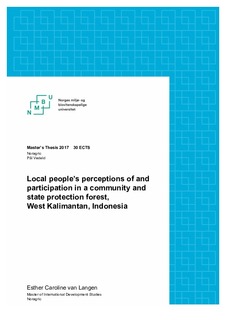| dc.contributor.advisor | Vedeld, Pål | |
| dc.contributor.author | van Langen, Esther Caroline | |
| dc.coverage.spatial | Indonesia, West Kalimantan | nb_NO |
| dc.date.accessioned | 2018-01-26T11:37:15Z | |
| dc.date.available | 2018-01-26T11:37:15Z | |
| dc.date.issued | 2017 | |
| dc.identifier.uri | http://hdl.handle.net/11250/2479863 | |
| dc.description.abstract | This study explores the relationships between local people and forest protection initiatives in West Kalimantan, Indonesia. The goal of this thesis has been to uncover interactions with and perceptions of local people towards a community-led versus a state-led forest protection effort, and reveal the extent to which these two are robust and participatory. A sustainable livelihoods approach was used to understand the way local people live their lives and the extent to which they rely on the forests, while Harmon & Putney’s (2003) value classification system was adopted to assess the ways local people value the forests and perceive the forest protection efforts. Further, Ostrom’s (1999) design principles and Pretty’s (1995) typology of participation were merged and applied during data collection and analysis to uncover the institutional soundness and participatory nature of the community and state forests. Data was collected through both structured questionnaires and semi-structured interviews with local people and implementers. Findings show that local people foster a deep connection with the forests and rely on them for a range of forest products. The extrinsic and intrinsic value of local people translated into high levels of local support for the protection initiatives, and a general willingness to get involved. While the community forest mostly adheres to Ostrom’s institutional framework, the state forest insufficiently enforces or encompasses these principles. The community forest’s institutional robustness renders an environment where participatory practices are incorporated to varying degrees. Yet, in the state forest, participation was not documented. Ultimately, local people perceived the community forest’s condition to be improving, while in the state forest the condition was perceived to be worsening. Suggesting institutional robustness and participation impact the soundness of forest protection. | nb_NO |
| dc.language.iso | eng | nb_NO |
| dc.publisher | Norwegian University of Life Sciences, Ås | nb_NO |
| dc.rights | Attribution-NonCommercial-NoDerivatives 4.0 Internasjonal | * |
| dc.rights.uri | http://creativecommons.org/licenses/by-nc-nd/4.0/deed.no | * |
| dc.title | Local people's perceptions of and participation in a community and state protection forest, West Kalimantan, Indonesia | nb_NO |
| dc.type | Master thesis | nb_NO |
| dc.description.localcode | M-DS | nb_NO |

